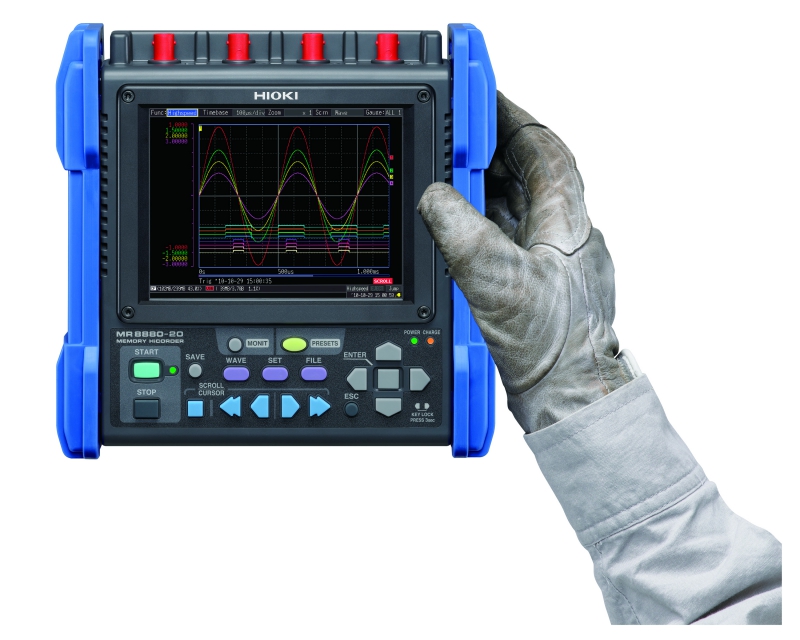The advantage of handheld oscilloscopes is that they can be taken to equipment and tested in situ, unlike a bench scope where components have to be dismantled from the equipment and brought to the bench.

The Hioki MR8880
The most commonly used oscilloscopes from last century were typically limited to two measurement channels. For measuring and analysing three-phase inrush current, modern hand-held instruments that provide a channel for each phase obviates the need to use complicated analysis methods like the two-wattmeter approach for example.
Handheld oscilloscopes combine the performance of traditional bench scopes with paperless recording of multiple measurement channels - useful for installing, commissioning and maintaining industrial and electronic equipment in the field.
Viewing a captured waveform allows an engineer to determine how fast the current drops from startup current to normal running current on each phase. Inrush current is the initial surge of current drawn when voltage is first applied as a circuit is closed.
Motors, power supplies, fluorescent lighting and High Intensity Discharge (HID) lamps all have inrush current characteristics that can be captured and analysed to help identify circuit problems.
Three-phase measurement
Three-phase motors obtain their starting motion from the phase difference between the three voltages applied. The three phase voltages create a rotating force, causing a stator to turn. A star/delta switch on a three-phase motor reduces the inrush current by a factor √3.
Each motor has unique starting characteristics that must be taken into consideration – not only the internal motor design but also external factors such as voltage amplitude, ambient temperature and load affect inrush current.
The Fluke ScopeMeter 190 Series allows capture of inrush currents into memory on location and examined later with FlukeView software. Current peaks and switch time parameters can be determined with full detail using cursors and zooming functions. The Fluke 192C ScopeMeter provides up to 200 MHz bandwidth to capture high frequency signals, boasting 2.5 GS/s sampling and improved memory and triggering abilities.
The Hioki MR8880-20 Portable Memory Recorder provides four analogue recording channels plus eight logic channels, allowing directly input of 600V AC/DC (CAT III) and 300V AC/DC (CAT IV) voltage and measurement to 2000V DC/1000V AC (CAT II) with a differential probe.
The MR8880 can help check for fluctuations in low-voltage signals such as instrumentation or sensor outputs, through 14-bit resolution A/D conversion and by combining a high-sensitivity 10 mV/div range and a 5 Hz filter for noise rejection to stabilise measurement at the sensor output.
The MR8880-20 is capable of mixed recording of RMS values, DC voltage, and logic signals, allowing it to simultaneously record data describing the interrelationships between equipment power supplies and UPS output and control signals, for example to investigate why an office power supply exhibits instability.
Two-channel scopes
Not all measurements require four channels and as stated earlier bench oscilloscopes were traditionally two-channel instruments. The UNI-T UTD1082C Handheld Digital Oscilloscope measures two channels at 80MHz bandwidth, and features sampling rate of 500MS/s.
It also features rise time of ≤4.5ns, memory depth of 7.5kpts, vertical sensitivity of 5mV-50V/div and time-based range of 5ns-50s/div. Multiple trigger modes include edge, pulse video and alternate as well as setup, waveform and bitmap storage modes. A USB port is built into the unit to interface with a PC.
As well oscilloscope functions the UTD1082C also includes a suite of multimeter functions and can be used to measure DC voltage from 600mV to 1000V, AC voltage (45Hz-400Hz) from 600mV to 700V, DC current from 6mA to 6A, AC current from 6mA to 6A, resistance from 6KΩ to 60MΩ and capacitance from 6nF to 600μF.
The Siglent SHS1102 Handheld Oscilloscope features a dual-channel bandwidth of 100MHz with a large 5.7 inch colour screen. It is suitable for use in a wide range of different applications including power electronics testing.
The SHS1102 is useful for testing switching mode power supplies, inverters, converters and lighting, wind power generators, PV power and other new energy equipment tests, as well as automotive electronic testing, electrical vehicle testing, industrial power system testing, field testing, educational applications and more.
The SHS1000 series comes with built-in IsolatedChannel technology, a patented unique technique used by Siglent to provide isolation from both ground and between channels. Also integrated into the SHS1102 is a fully-functional multimeter that is capable of measuring DC/AC voltage, DC/AC current, resistance, capacitance, diode and continuity.
The Extech MS420 20MHz Digital Oscilloscope helps identify, analyse and calculate the frequency of waveforms on two channels, displaying results on a 97mm colour LCD display. An auto set function optimises the range, time-base, position and triggering. Also included is a trigger hold-off function to ensure stable viewing of multiple waveforms.
XY mode and FFT function displays component frequencies and 20 automatic measurements include average, cycle, frequency, peak to peak, RMS and then fifteen more valuable measurements. The Extech MS420 20MHz Oscilloscope can complete waveform math using addition, subtraction, multiplication and division.
There is also an average mode which can be set for smoothing waveforms, as well as analogue persistence mode that mimics the classic analogue cathode ray tube (CRT) phosphor display characteristics to enable users to observe dynamic signals in a familiar way. True RMS multimeter functions include AC/DC voltage and current, diode, continuity, capacitance and resistance.
For further information, please visit PASS Ltd’s specialist Handheld Digital Oscilloscopes web page.


